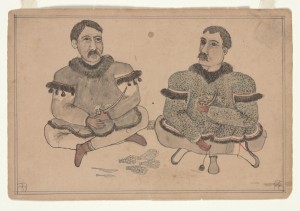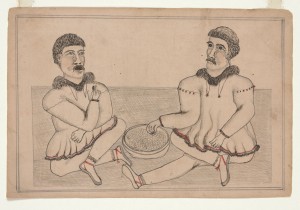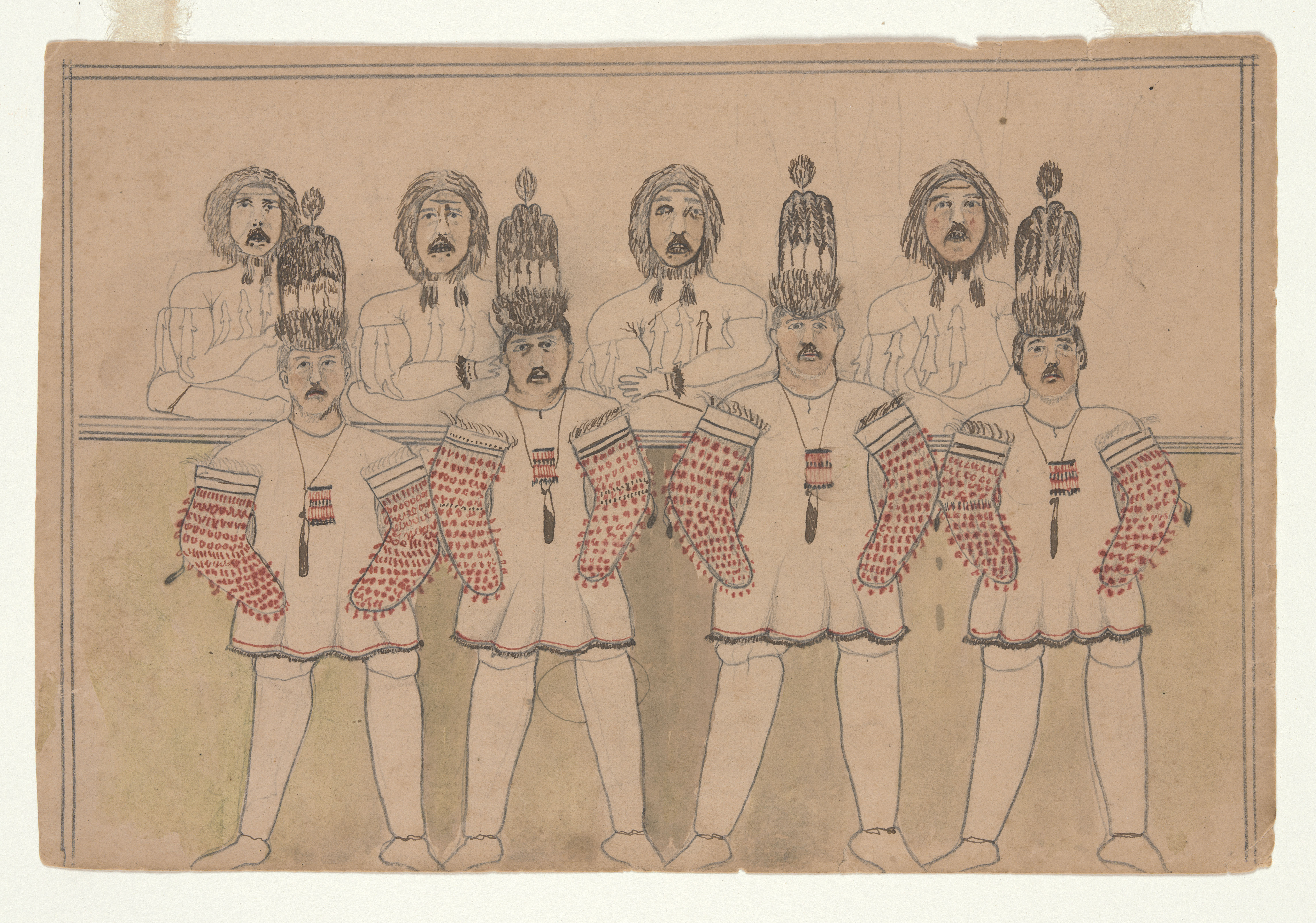I. About this Exhibition
This website is a companion to an exhibition of ten extraordinary drawings representing aspects of the kivġik (Messenger Feast), a ceremonial complex performed in many Inupiat communities in Alaska. The drawings offer remarkably detailed depictions of the regalia and dance steps used by the participants who gathered from diverse communities to participate in the event. These dances continue to be performed today by the leaders of Inupiat villages in Western and Northern Alaska, in many cases resembling what is shown in these century-old drawings quite closely.
King Island dancers performing the Wolf Dance in the same regalia as is worn in the drawing above. source: https://www.youtube.com/watch?v=F9S7RA5Z1mg posted by Nahvakana
The drawings are now part of the collection of Columbia University Art Properties in Avery Architectural & Fine Arts Library; they came to the university as part of the Bush Collection of Religion and Culture, an assemblage of works by non-European artists made by Philosophy and Religion Professor Wendell Ter Bush in the early twentieth century for their religious significance. The collection was described by Professor Bush as “Eskimo drawings,” and, because of their resemblance to documented Inupiat drawings in collections in Alaska and Washington, D.C., we believe that they were made by Seward Peninsula Inupiat people working closely with missionary-teachers Tom and Ellen Lopp in the village of Kingigan in Wales, Alaska.
While artists from many Inupiat communities have been making graphic art since ancient times, the style of these drawings is novel for its time, for the makers of these works engage new representational strategies, including exploring Western means of giving the illusion of volume and space such as overlapping objects, rendering similar figures in diverse poses and using scale to imply distance from the viewer. We do not know what these choices indicate, but the Lopp’s letters suggest that this kind of document was appealing to non-Natives and the fact that the drawings ended up in New York City implies that they may have been designed to circulate outside of the Seward Peninsula. Tom and Ellen Lopp, the missionary teachers sent to Kingigan in the 1890s, were connected to the broader U.S. Indian school system which had a history of teaching drawing and of encouraging students to make drawings for sale as a means of gaining a personal income and increasing public support for the schools. (Hutchinson 1999 chapter 2). Both the subject matter and the format of these drawings are likely the result of the teachers’ influence. Indeed, a collection of similar drawings in the Smithsonian Institution was exhibited in the early twentieth century as the work of students at the school at Wales that demonstrate the school’s successful implementation of the curriculum and goals of the Indian School system. (Phebus 1972, 11-16)
The exhibition and the website share research done by graduate students over the course of a semester. Our goal is to begin contextualizing and interpreting these little-known drawings and facilitate access to these depictions of ancestors practicing still-vital dances for contemporary Seward Peninsula people and with all audiences interested in the intersections between art, aesthetics, and cultural politics.
The works in this exhibition were made during a time of extreme hardship caused by the United States colonization of Alaska Native territory. They were made using materials and according to formats that were introduced by outsiders whose goal was to eradicate aspects of traditional life seen as incompatible with modern, civilized society. Nevertheless, the curators of this exhibition believe that these drawings are rich with information about Inupiat life and culture. We see the works as confirming community values and practices across periods of historical and cultural change. On this website, we connect these drawings with with a longer history of Inupiat art and material culture from ancient times to the present. Our work in producing this website occurred primarily in the libraries and classrooms of New York City. We hope to expand and revise the material on this page as we hear more from the members of the communities from which the artists and the people in the pictures come.
Notes on Art and Cultural Survival
The Bush Collection of Religion and Culture
Missionary Education at Wales: the Lopps

Unknown Inupiat artist, Drawing E, Men in different clothing with carved pipes, pencil and ink on paper, Columbia University Art Properties in Avery Art and Architecture Library (C00.1483.303)

Unknown Inupiat artist, Drawing F, Two men in similar dress sharing berries, pencil and ink on paper, Columbia University Art Properties in Avery Art and Architecture Library (C00.1483.304
Source for this page:
Elizabeth W. Hutchinson The Indian Craze: Primitivism, Modernism, and Transculturation in American Art 1890-1915 (Duke University Press, 2009)
George E. Phebus, Alaskan Eskimo Life in the 1890s as sketched by native artists (Smithsonian Institution Press, 1972)

September 10, 2018 at 5:48 pm
This website is a companion to an exhibition of ten extraordinary drawings representing aspects of the kivġik (Messenger Feast), a ceremonial complex performed in many Inupiat communities in Alaska. The drawings offer remarkably detailed depictions of the regalia and dance steps used by the participants who gathered from diverse communities to participate in the event. These dances continue to be performed today by the leaders of Inupiat villages in Western and Northern Alaska, in many cases resembling what is shown in these century-old drawings quite closely.